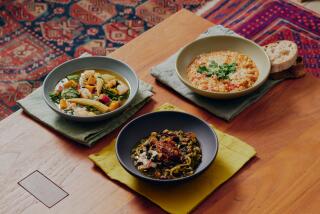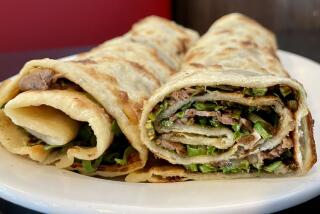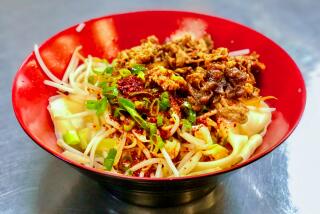Chinese Lessons
- Share via
While most college students were whipping out the ramen or the macaroni and cheese, my friends and I were enjoying Chinese feasts. The idea for these meals began when my housemate cooked some Chinese-style beef for her boyfriend, a meat-only type of guy. She added to it the Shanghai noodles and tomatoes with the hope that he would eat something nutritious without realizing it.
As he ate, the rest of us in the house would watch like scavengers, hoping he would leave a tiny morsel for us to devour. Sometimes he’d leave some noodles, but never the beef.
It didn’t take long for my friend to catch on and start making enough to go around. Gradually, the rest of us learned how to make the dish on our own.
Menu (30 MINUTES OR LESS)
Stir-Fried Beef with Stewed Tomatoes and Noodles
Chinese Broccoli with Oyster Sauce
Countdown
30 minutes before: Slice beef, mix marinade and let beef marinate at least 10 minutes.
25 minutes before: Put water on to boil for noodles and Chinese broccoli. Clean and cut Chinese broccoli. Wash, core and slice tomatoes. Slice green onion and garlic. Set up beef stir-fry ingredients in small bowls and line them up next to the wok.
15 minutes before: Begin cooking Chinese broccoli in boiling water. Bring tomatoes and soy sauce to boil, then let simmer.
12 to 10 minutes before: Drain Chinese broccoli and keep warm on platter. Begin cooking noodles in boiling water.
8 minutes before: Stir-fry beef, in 2 batches if necessary.
5 minutes before: Turn heat off tomatoes and keep warm.
5 to 3 minutes before: Drain noodles and place in serving bowl. Top with stewed tomatoes and beef. Serve the broccoli on a separate plate or on the same serving platter with oyster sauce drizzled on top or on side.
Ingredients
Shopping List
1 (1/2-pound) flank steak
1 bunch green onions
1 (7-OUNCE) bottle oyster sauce
1 (5-OUNCE) bottle sesame oil
2 tomatoes
1/2 pound fresh wheat flour (Shanghai) noodles
1/2 pound Chinese broccoli
Staples
Cornstarch
Garlic
Salt
Soy Sauce
Sugar
Vegetable oil
STIR-FRIED BEEF WITH STEWED TOMATOES AND NOODLES
1 (1/2-pound) flank steak
4 teaspoons cornstarch
Water
1/4 teaspoon sugar
Soy sauce
2 tomatoes, each sliced into 8 wedges
Sesame oil
1 tablespoon vegetable oil
1 clove garlic, minced
1 green onion, chopped
2 tablespoons oyster sauce
1 tablespoon salt
1/2 pound fresh wheat-flour (Shanghai) noodles
Slice steak into 3 strips lengthwise, then into 1/8-inch-thick slices.
Combine cornstarch, 4 teaspoons water, sugar and 1 tablespoon soy sauce in nonreactive shallow bowl or pan. Add beef and let marinate at least 10 minutes.
Cook tomatoes and 1/4 cup soy sauce in saucepan over high heat until soy sauce comes to boil. Reduce heat and simmer, covered, 5 to 7 minutes. Do not stir or tomatoes will fall apart. Remove from heat and add several drops sesame oil to taste.
While tomatoes simmer, add salt to pot of boiling water and let water return to boil. Add noodles and cook until just tender, 5 to 7 minutes.
Add vegetable oil to heated wok or skillet and heat about 30 seconds over high heat. Add garlic, green onion and marinated beef strips, tossing rapidly until beef turns deep brown, 3 to 4 minutes. Add oyster sauce and toss.
Drain noodles and place on serving bowl. Top with beef, then tomatoes. Toss at table just before serving.
2 servings. Each serving:
691 calories; 4,344 mg sodium; 43 mg cholesterol; 15 grams fat; 103 grams carbohydrates; 36 grams protein; 4.85 grams fiber.
CHINESE BROCCOLI WITH OYSTER SAUCE
8 cups water
1 tablespoon salt
1/2 pound Chinese broccoli, tough ends removed
2 tablespoons oyster sauce
Bring water to boil. Add salt. When water returns to boil, add broccoli and cook until just tender, 3 to 5 minutes. Pour oyster sauce over broccoli or serve on side.
2 servings. Each serving:
57 calories; 4,561 mg sodium; 0 cholesterol; 0 fat; 11 grams carbohydrates; 3 grams protein; 1.26 grams fiber.
(BEGIN TEXT OF INFOBOX / INFOGRAPHIC)
CHEF’S TIPS
*Flank steak, which is a thin cut and relatively free of excess fat, is quicker to cook than many other cuts of beef because it does not need to be pounded or trimmed.
*When stir-frying, it’s important to cook in small batches. If too much food is in the wok at one time, it will steam instead of stir-fry.
*Variations on this menu include substituting rice for the noodles and stir-frying the Chinese broccoli with the beef instead of serving it on the side.
*Chinese broccoli, called gai-lan in Chinese, is a thinner cousin of the broccoli most non-Asians grew up eating. A close substitute is Italian rapini (also known as broccoli rabe). Common broccoli may be easily substituted.
(BEGIN TEXT OF INFOBOX / INFOGRAPHIC)
Kitchen Tip
Fresh Chinese wheat flour noodles, called yangchun mian or spring noodles in Chinese, are made, often by hand, of flour and water and may be round or flat. Cookbook author Nina Simonds says these are the oldest form of Chinese noodles.
They are frequently referred to as Shanghai noodles because they can be found in many Shanghai-style noodle dishes. However, Simonds points out that the noodles originated in northern China and are encountered in cities other than Shanghai. Fresh wheat flour noodles are usually found in Chinese markets; the dry form may be used if the fresh is unavailable. Linguine is also an acceptable substitute.


